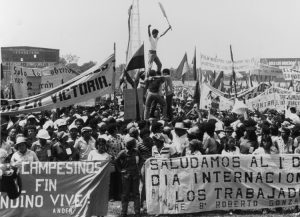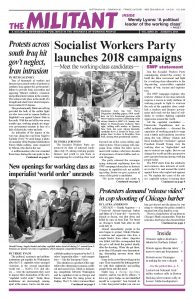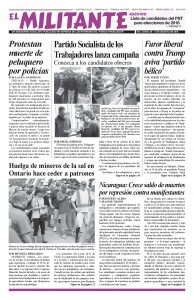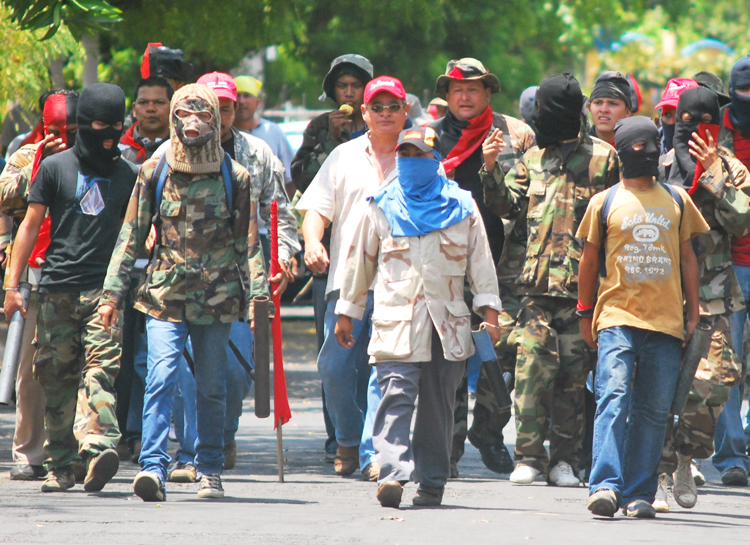Conditions leading to widespread protests against the government of President Daniel Ortega this year have been in the making for more than a decade.
It was an explosion of pent-up grievances against what many working people and middle-class layers in Nicaragua see as a corrupt and authoritarian government. The worldwide capitalist crisis and the collaboration of Ortega’s ruling party — the Sandinista National Liberation Front (FSLN) — with the Nicaraguan capitalist class added to the tensions.
The wave of protests began April 19, following the attack by police and government-organized thugs on retirees protesting anti-working-class “reforms” in social security.
The government’s repression of the protests — resulting so far in over 300 killed, 2,000 injured and hundreds arrested — shattered the false image Ortega promotes that his government is a continuation of the popular revolution led by the FSLN in the 1980s.
Once a revolutionary party with a working-class program, the FSLN since the late 1980s has turned its back on defending the interests of working people and sought open collaboration with the country’s wealthy ruling families.
1979 Sandinista Revolution
In 1979 the FSLN led an insurrection that overthrew the U.S.-backed dictatorship of Anastasio Somoza and inspired working people around the world.

Workers and farmers in Nicaragua and the Caribbean island of Grenada in 1979 “did more than oust corrupt and brutal tyrants who had sold these nations’ patrimony to Washington,” says the introduction to the “The Rise and Fall of the Nicaraguan Revolution,” in issue no. 9 of the Marxist magazine New International. “They displaced from political power the entire class of exploiting landowners and big businessmen, ushering in popular revolutionary governments.”
At that time the FSLN leadership pursued a course that promoted the organization and mobilization of workers and peasants to confront capitalist economic relations that deprive working people of the social wealth our class creates. The revolutionary government encouraged the formation of unions and peasant organizations. Women fighting for equality got support from the government. Indigenous people and Afro-Nicaraguans on the Atlantic Coast opened a struggle against racial discrimination and underdevelopment, and to wrest control of resources in the region, long plundered by U.S. and other foreign bosses.
The 1969 historic program of the FSLN is also available in New International no. 9. It guided the political work led by Carlos Fonseca and the nucleus of Nicaraguan youth of his generation who, inspired to emulate the Cuban Revolution, formed the FSLN in the early 1960s.
That program called for distributing land to the peasants, “taking what was stolen by the big landlords and giving it back to small producers who labor on it,” and for toilers to mobilize to “create a Nicaragua that is free of exploitation, oppression, and backwardness.”
The confidence and anti-imperialist mobilizations by working people in Nicaragua during the opening years of the revolution incurred the wrath of the U.S. rulers, who organized a murderous mercenary war to destroy the revolution. Nicaraguan workers in city and countryside fought arms in hand and defeated the counterrevolution.
Gradually, however, FSLN leaders turned their back on their program. Instead of mobilizing workers and peasants to take control of production and the land, they sought “more pragmatic” alliances with Nicaragua’s capitalists, calling them “patriotic producers.” By the late 1980s the revolution had been lost. The regime that was defeated in the February 1990 election had ceased to be a workers and farmers government.
Ortega and the entire top leadership of the FSLN now defended reliance on capitalist market relations and integration into the world capitalist system as the way forward. They rejected the example set by the Cuban Revolution and its leadership of building a communist party rooted in the working class, to overthrow capitalist rule and advance a socialist course.
A path ‘back to power’
Out of power for 16 years, Ortega used social protests and strikes, and blocs with layers of the capitalist class, to press for concessions from Liberal Constitutional Party (PLC) governments.
In 1999 the PLC agreed to enter a power-sharing pact with the FSLN, dividing up appointees to the Supreme Electoral Council that oversees elections. The law was changed to allow a presidential candidate to win with as little as 35 percent of the votes. Ortega won the 2006 election with 38 percent.
One demand raised by participants in recent protests is to change the composition of the FSLN-controlled courts and electoral council as part of any agreement to hold early presidential elections. Otherwise, they say, Ortega will steal the elections.
By 2006 Ortega had convinced many capitalist and imperialist investors that he was a “new Daniel” and the FSLN’s revolutionary road was a thing of the past. His election that year “marked a new course,” Ortega told the Iberoamerican Association of Chambers of Commerce in April 2017. “Here, we have a single government: workers, businessmen, and the state,” he said, pretending that a government can serve the interests of both exploiting and exploited classes.
Since 2009, only four of the 105 economic laws passed by the National Assembly were opposed by the High Council of Private Enterprise (COSEP), the main organization of Nicaragua’s capitalist business owners.
Ortega’s policies have drawn praise from the International Monetary Fund and other imperialist financial institutions. Low wages, containing working-class resistance through FSLN-controlled unions and relative stability have made Nicaragua a preferred destination for capitalist investment in Central America.
More than 120,000 workers and their families depend on jobs in several free trade zones, manufacturing clothing and other items for foreign bosses.
Capitalist investors have lauded Nicaragua’s economy as a “success story,” averaging 4 percent growth in the last decade. But this “prosperity” hasn’t reached the vast majority of toilers.
During our visit to Nicaragua in May, we asked one worker what he thought about the government’s assertion that protests would drive away foreign employers and cause more unemployment. “I doubt it. They can’t find any cheaper labor,” he said. Nicaragua has the lowest minimum wage in Central America, about $180 a month.
The minimum wage for rural workers is set at $125 a month. “When you have a basket of basic food items that costs $440, you can only cover a quarter of it,” admitted Yolanda Arias, a leader of the FSLN-led Rural Workers Association.
Ortega has been able to temper the impact of capitalist and imperialist plunder with social programs financed through Venezuela oil assistance, including distribution of bags of food to poor families, loans to small farmers and to workers starting cooperatives, subsidies for electric bills and public transportation. The government also increased spending on education and health care.
This helped Ortega retain a base among the peasantry and urban poor. But, it’s a base that is dwindling under the blows of the capitalist world economic crisis and the FSLN’s repression.
Many workers we spoke with expressed hatred of the patronage practices that demand political loyalty to Ortega — attendance at pro-government rallies, for example — in exchange for jobs and benefits. “‘I give you this in return for your family’s support,’ they demand of us,” said Raymundo González, a worker we met in Masaya in May.
The accumulated indignation, countless humiliations, arbitrariness, nepotism, abuses of authority by government officials and FSLN functionaries have all contributed to the discontent that blew up in April and continues against government attacks.


